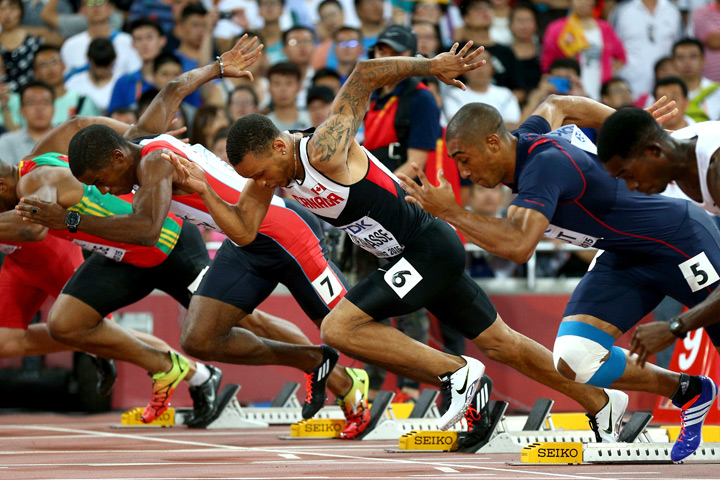Five years ago, Andre de Grasse ran down a track at York University in Toronto with very little idea what he was doing.

His form wasn’t that of a professional sprinter. He didn’t even know how to use a starting block. But his former coach — the man credited with discovering De Grasse — saw potential.
“He was just kinda trying to run fast,” recalled Tony Sharpe in an interview with Global News. “I said, ‘Wow, who’s that’?”
Today, very few track-and-field watchers would struggle to identify De Grasse. At 21 years old, the Markham, Ont. native has claimed Olympic bronze in the 100-metre dash.
WATCH BELOW: Canadian Andre De Grasse wins bronze in the 100m final

He posted a personal best time of 9.91 seconds, and brought home Canada’s first medal in the marquee event since Donovan Bailey smashed the world record and took gold in 1996. In qualifying rounds for the 200-metre Tuesday morning, De Grasse handily won his heat in 20.09 seconds.
READ MORE: Andre De Grasse to compete in 200-metre semifinal
It took hard work to get to this point, acknowledged Sharpe, but De Grasse also has a raw, natural talent for running that gives him an edge. Sharpe described the innate ability as “magical.”
Here’s what makes De Grasse so fast:
Muscle composition
Like most world-class sprinters, De Grasse naturally possesses a high proportion of what are called “fast-twitch” (or Type II) muscle fibres. He was genetically predisposed to possess more of these fibres, which produce the explosive power that sprinting requires rather than the longer-term muscle engagement needed for long-distance running.
READ MORE: Photo of Usain Bolt smirking at runners behind him is the latest Olympic meme
For most of us, the split between the two types of muscle fibre is close to 50/50, usually with a few more fast-twitch fibres. But for someone like De Grasse, the proportion may be much higher — closer to 80 per cent fast-twitch.
WATCH BELOW: Andre De Grasse’s coach on what physically makes him such a good sprinter

Force
De Grasse is relatively short at 5-foot-9, but Sharpe says his height (and therefore the length of his stride) as compared to someone like Usain Bolt (6-foot-5) matters less than the amount of sheer force he can produce.
“Sprinters come in all shapes and forms … it’s really about force,” Sharpe explained. “How much force can you apply to the track versus mass or weight?”
De Grasse is not only incredibly strong, Sharpe said, “he applies (the force) going in the right direction.”
Technique
In a word, said Sharpe, De Grasse’s running technique below the waist is “flawless.” There is very little that could be modified to make him faster in that respect. He also naturally stands tall when he runs, his former coach said, something that doesn’t come easily to all sprinters.
“A lot of kids you have to teach them to do that.”
The one oddity is De Grasse’s right arm, which he tends to keep extended when he sprints, rather than bending it like his left. De Grasse himself blamed the “Andre arm” on an old basketball injury in a recent interview with the International Association of Athletics Federations, and has acknowledged that it’s something he’s actively trying to correct.
With Bolt (still considered the world’s fastest man) out of the field at the next summer Olympics in 2020, Sharpe predicted that De Grasse will lead the next generation of record-breaking sprinters on the Olympic stage.
“There’s a changing of the guard happening right now, and Andre is going to lead that new group of sprinters into the future.”





Comments